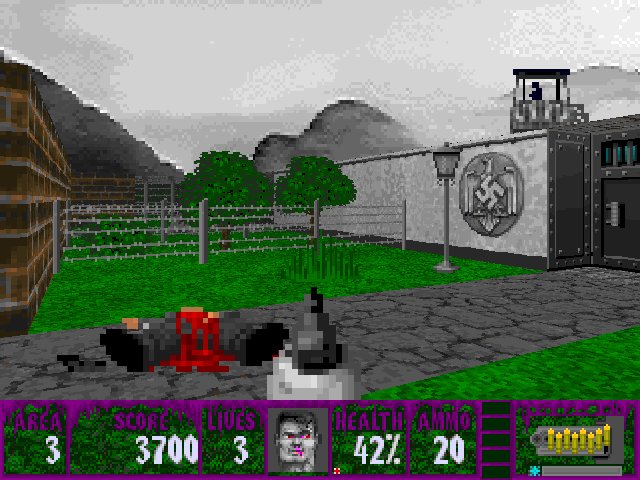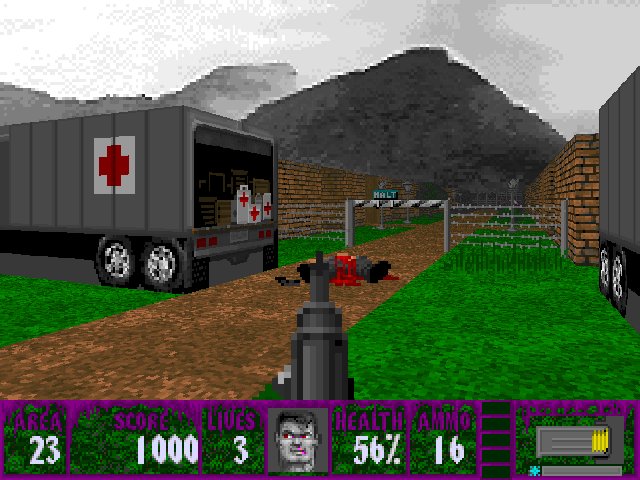The past weekend I downloaded and read some of Thomas' Mapping Anthology. It's a very interesting read for those of you who are interested in modding, and mapping specifically. Over the course of 124 pages Thomas goes into detail about what inspired him, and how his mods came to be. Or not, as unfinished projects are included as well. It made me reminisce about some of my own experiences with the various development stages modding constitutes of. Which is why I decided to write about my experiences with a mod that's arguably the biggest mod I've worked on so far: Operation: Eisenfaust Origins.
I joined this project in 2007 (has it been that long?!) as a relatively new mapper; I had not released anything yet, and my mapping experience was mostly limited to maps for the original Wolf3D. I had dabbled a bit with the more advanced features available at the time e.g. floor/ceiling textures, shading and parallax skies, so when the opportunity arose to work on a mod which would contain these features (and more), I figured it would be a great way to get the hang of all these advanced features, while at the same time it seemed like a great learning experience, both as a mapper and a modder.
And it was. Released in 2012, Eisenfaust Origins had a turbulent development proces; a topic I'm sure will come up several times while I discuss the levels. But as a learning experience it was not something I would have wanted to miss out on. And let's not forget, while the development proces was turbulent at times, the mapping was always something I enjoyed a lot. The joy is in the doing. And it introduced me to the team that in the future would be known as Team Raycast.
I joined this project in 2007 (has it been that long?!) as a relatively new mapper; I had not released anything yet, and my mapping experience was mostly limited to maps for the original Wolf3D. I had dabbled a bit with the more advanced features available at the time e.g. floor/ceiling textures, shading and parallax skies, so when the opportunity arose to work on a mod which would contain these features (and more), I figured it would be a great way to get the hang of all these advanced features, while at the same time it seemed like a great learning experience, both as a mapper and a modder.
And it was. Released in 2012, Eisenfaust Origins had a turbulent development proces; a topic I'm sure will come up several times while I discuss the levels. But as a learning experience it was not something I would have wanted to miss out on. And let's not forget, while the development proces was turbulent at times, the mapping was always something I enjoyed a lot. The joy is in the doing. And it introduced me to the team that in the future would be known as Team Raycast.
Over the course of the 5-year development stage I had to deal with some setbacks: coders leaving (in that regard Team Raycast is almost like Red Hot Chili Peppers and their guitarists, though I would say we have found our John Frusciante now), features being added mid-mapping, source codes being lost, and after a year or so in the development stage my mapping skills had improved drastically; to the point where my older maps looked, well, shit. About 10 maps were scrapped because they didn't cut it quality-wise. However, the first level, Prison Break, survived all this. It was the first level I ever made for this mod, and though it has been
remapped slightly several times, it is one of the few early levels that has remained
largely intact.
It is in an opener in the same vein as the original Wolf3D: a prison escape that introduces the setting of the mod. You play, once again, as BJ Blazkowicz. After his encounter with Hans Grosse, he discovered the plans for Operation: Eisenfaust. He goes to investigate one of the marked locations, where he gets caught. He then discovers first-hand what is happening in the camp, as he is assimilated to be a mutant.
It is in an opener in the same vein as the original Wolf3D: a prison escape that introduces the setting of the mod. You play, once again, as BJ Blazkowicz. After his encounter with Hans Grosse, he discovered the plans for Operation: Eisenfaust. He goes to investigate one of the marked locations, where he gets caught. He then discovers first-hand what is happening in the camp, as he is assimilated to be a mutant.
We start in a prison area, where it seems that BJ has escaped from his cell (he must have a lot of experience with that by now!). There are several doors in the first area, though the more seasoned Wolfer will probably anticipate that those rooms are cells. Naturally it never hurts to explore those cells, as they can contain secrets. Regardless if you search these cells are not, a patrolling guard will enter the room. This patrolling guard right away adds tension to the level, as this might not have been anticipated by the player. Next to that, you start out with only a knife to your disposal. As such, it puts you right in the middle of all the action.
Though it has to be stated that this 'twist' to the story happened out of necessity. Originally known as Sonderkommando Revolt, the mod attracted some controversy after a gaming website took notice of the trailer (I won't be linking to it here). The sensationalistic way they handled their coverage of the mod led to an explosion of views, which led to more and more discussion. And personally, I'm fine with a person not wanting to play a game because it's too violent or the horrors portrayed in a game hit too close to home. This is understandable, but personally I don't see why that must lead to a ban given the fact that the majority of the mainstream video games are much more violent. Just don't play it; but never ever censor anything.
The attention given to the mod and to the project leader, including an interview where the site misused doomjedi's naivety regarding interviews, led to the cancellation of Sonder. This meant that years of work went down the drain. This was a hard blow; while we understood the personal pressures doomjedi had to deal with (journalists calling him at home, his job being under pressure), we were disappointed because our work was for nothing. At first we tried to convince doomjedi to still release the mod; we did not want to be censored and give in to a sensationalist gaming website. Next to that, many commenters were on our side which strengthened our conviction. It was a matter of principle for me and the other team members, not knowing the full extent of how much doomjedi was bothered by the attention. He was phoned by journalists and radio-dj's; without any preperation he was live on the air all of a sudden. I can understand that this can cause anxiety, especially for someone who is somewhat of a private person. It's something that wasn't clear to me at the time, mostly because I didn't know to what extent this happened. If I had known the full extent, I probably would not have gone on so much about releasing it regardless. Part of that is also that I personally didn't see the problem with having to do interviews, which I thought was all that was happening.
Some time went by, and the storm of controversy disappeared as quickly as it had appeared. We started working on other mods, such as Batman vs. Bane. During this project, a coder by the nickname 'Linuxwolf' joined our team. Next to being a fantastic coder, he was also the one who came up with the idea to reboot Sonder. But we needed a story for that, something that fitted the theme. Basically a story where most of the levels could remain intact. We settled on the idea of a mutant camp; it was the idea that would have little remapping, it stays close to the original and it was a subversion of a Wolf3D trope: mutants being the enemies.
Naturally this meant that graphics had to be changed, as the original version had quite a lot of prisoner imagery. Luckily, the story fitted in such a way that most maps needed little remapping. The first level is one of the few levels that, apart from the prisoners being replaced with mutants, stayed largely intact. It's for that reason that it is a somewhat special level to me: it is the first one I made for the project, and it stayed for the entirety of the development stage.
Some trivia:
-The only remapped part is the last prison area; at first this was a much tinier and less challenging area which was, to be honest, boring. After that was remapped, the ending had to be remapped again. This was because we made the switch from elevators to end level objects.
-I created the tune for the level. The Bobby Prince influence is very obvious: a simple melody based on the blues scheme, something Bobby used for some of his tunes at well.
You can watch Balames' playthrough of level 1 below;




No comments:
Post a Comment